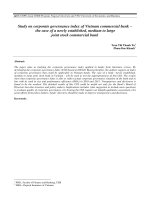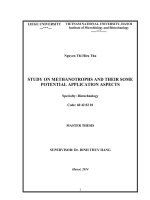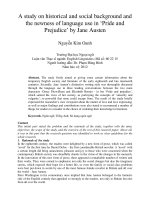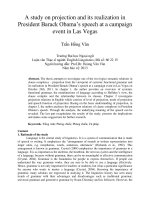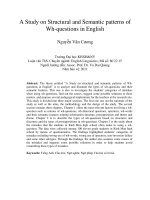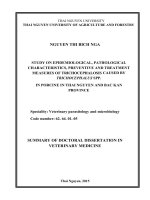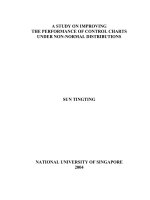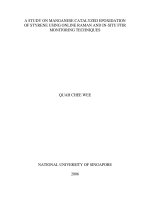Study on ignition and combustion of gas jet and liquid spray fuels
Bạn đang xem bản rút gọn của tài liệu. Xem và tải ngay bản đầy đủ của tài liệu tại đây (4.02 MB, 123 trang )
Study on Ignition and Combustion of
Gas-Jet and Liquid-Spray Fuels
September 2009
Nguyen Ngoc Dung
Content
CHAPTER 1 INTRODUCTION
1
1.1. Background introduction
1
1.2. Alternative fuels
1.2.1 Hydrogen
1.2.2 Natural gas
1.2.3 Biodiesel fuel
1.2.4 Gas-to-liquid fuel
5
6
7
9
10
1.3. Objectives and approaches
11
1.4. The structure of this thesis
13
References
13
CHAPTER 2 METHODOLOGY FOR THE RESEARCH OF IGNITION AND
COMBUSTION BY CONSTANT-VOLUME VESSEL UNDER DIESEL-ENGINE
CONDITIONS 18
2.1. Introduction
18
2.2. Experimental setup and procedure
2.3.1 Constant-volume combustion vessel
2.3.2 Optical diagnostics
2.3.3 Experimental procedure
18
18
20
21
2.3. Determination of ignition delay
2.3.1 Ignition delay for gaseous fuel jets
2.3.2 Ignition delay for liquid fuel sprays
23
23
24
2.4. Combustion analysis
25
2.5. Experimental conditions
27
2.6. Conclusion
28
References
28
i
CHAPTER 3 SPONTANEOUS IGNITION AND COMBUSTION OF GASEOUS
FUEL JETS UNDER DIESEL COMBUSTION CONDITIONS
30
3.1. Introduction
30
3.2. Experimental
33
3.3. Results and discussion
3.3.1. Penetration of hydrogen and natural gas jets
3.3.2. Effects of temperature
3.3.3. Effects of nozzle-hole diameter
3.3.4. Effects of injection pressure
3.3.5. Effects of ambient pressure
3.3.6. Effects of oxygen mole fraction
33
34
35
40
43
46
48
3.4. Conclusion
51
References
52
CHAPTER 4 FUNDAMENTAL STUDY ON IGNITION AND COMBUSTION OF
BIODIESEL FUEL FROM WASTE COOKING OIL
55
4.1. Introduction
55
4.2. Experimental
57
4.3. Results and discussion
4.3.1. Development of biodiesel fuel sprays
4.3.2. Effects of t emperature at an ambient pressure of 4 MPa
4.3.3. Effects of temperature at an ambient pressure of 2 MPa
58
59
61
66
4.4. Conclusion
68
References
69
CHAPTER 5 IGNITION AND COMBUSTION OF GAS-TO-LIQUID FUELS
72
5.1. Introduction
72
5.2. Experimental
74
ii
5.3. Two-stage ignition determination
76
5.4. Results and discussion
5.4.1. Spray penetration and flame development of GTL fuels at base condition
5.4.2. Effects of temperature at 4 MPa
5.4.3. Effects of temperature at 2 MPa
5.4.4. Effects of injection pressure
5.4.5. Effects of oxygen mole fraction
5.4.6. Effects of nozzle-hole diameter
77
78
80
86
91
97
105
5.5. Conclusion
107
References
109
CHAPTER 6 CONCLUSIONS
113
6.1. Gaseous fuel jets
113
6.2. Biodiesel fuel from waste cooking oil
114
6.3. Gas-to-liquid fuels
115
6.4. Recommendation for future work
116
ACKNOWLEDGMENTS
117
LIST OF PUBLICATIONS
118
iii
CHAPTER 1
Introduction
1.1. Background introduction
Crude oil, gas and coal, known as fossil fuels, have played a crucial role in the world
economy and world energy market. Currently, modern industrial economies rely critically
on fossil fuels to supply energy for transportation and to produce electricity for industrial
and household purposes [1]. The growth in energy demand or the increase in fossil fuel
consumption is stimulated by many factors; predominant among them are the world
population growth, economic growth, and the industrialization of developing countries or
the continuous industrialization in developed countries [2]. The Energy Information
Administration (EIA-2009) has projected that energy consumption will increase at an
average 1.1 percent per annum. The world marketed energy consumption is projected to
grow 44 percent over the 2006 to 2030 period. Total world energy use rises from 472
quadrillion Btu in 2006 to 552 quadrillion Btu in 2015 and then to 678 quadrillion Btu 2030,
in which total energy demand in the non-Organization for Economic Cooperation and
Development (non-OECD) countries increases by 73 percent, compared with an increase of
15 percent in the OECD countries. In terms of global consumption, liquids are expected to
remain the most important energy source. World consumption of liquids and other
petroleum is expected to grow from 85 million barrels per day in 2006 to 91 million barrels
per day in 2015 and 107 million barrels per day in 2030 [3].
Fossil fuels possess many useful properties such as high energy density, safety and ease of
use compared to others energy sources. These advantages have made fossil fuel popular
during last century. In 2006, burning fossil fuels satisfied about 86 percent of world energy
consumption. Unfortunately, fossil fuels are non-renewable, and the limited resources are
currently being depleted. Shafiee and Topal [1] have computed and derived depletion times
1
for fossil fuels reserves, and report that crude oil, coal and natural gas are likely going to
be depleted in 35, 107 and 37 years, respectively.
The burning of fossil fuels produces harmful pollutants, which are destroying the
environment and harming people‘s life. The most dangerous product is the emission of
carbon dioxide (CO2). Carbon dioxide is one of the greenhouse gases that enhances
radioactive forcing and contributes to global warming, causing the average surface
temperature of the Earth to rise. World carbon dioxide emissions are predicted to rise from
29 billion metric tons in 2006 to 33.1 billion metric ton in 2015 and 40.4 billion metric tons
in 2030-an increase of 39 percent over this projection period, according to the IEA [3]. In
addition, about 700 million tons of carbon monoxide, 150 million tons of nitrogen oxides,
200 million tons of solid particles, and 200 million tons of sulphur dioxides are released
annually in the atmosphere [4]. The majority of these substances are produced by the
transport sector.
In the last three decades, the world has been confronted with energy crises due to the
decrease in fossil resources, with the increase in environment constraints, and with the
increasing prices of oil. Lowering of world CO2 emissions to reduce the risk of climate
change requires a major restructuring of the energy system. This situation brings as a
consequence the search of alternatives and renewable fuels, which have to be not only
sustainable, but also techno-economically competitive. Gaseous fuels of hydrogen, natural
gas and bio-fuels like ethanol, vegetable oil, biomass, biogas, synthetic fuels, biodiesel, etc.
are starting to be of high interest to the developed countries [4].
Liquid oils from petroleum are the main energy source for internal combustion engines.
Recently, the reduction of nitrogen oxides (NOx) and particulate matter (PM) in the exhaust
of diesel engines to meet the upcoming automobile emission regulations have become the
main directives for engine manufactures. For this purpose, engine makers have introduced
various techniques such as new modes of combustion [5,6], the high-pressure common-rail
injection system with electronic controlled [7-9], the exhaust gas recirculation system
(EGR) [10,11] and the aftertreatment system [12,13] for modern diesel engines because
2
they satisfy the increasingly more stringent emission regulations. Additionally, in order to
provide engine manufacturers with phenomenological models to guide their designs, many
researchers have started to develop methods to investigate diesel combustion mechanisms
with a focus on the processes that lead to the production of soot and nitrogen oxides. As a
result, a wide range of engine modifications have being developed and implemented to
achieve higher engine fuel efficiency and larger emissions reductions.
In direct-injection (DI) diesel engines, combustion sequence starts from the injection of fuel
toward the end of the compression stroke in a small volume of high-pressure, hightemperature gases at which point the injected fuel autoignites and combusts in the
expansion stroke. The combustion process is usually composed of a premixed combustion
phase, followed by a diffusion-combustion phase. During premixed combustion, the levels
of mixing are high and the local air-fuel ratio of the mixture range from above 14.5:1, the
stoichiometric value, to beyond the limit of flammability in the outer boundary of the spray
[14,15].
The efficiency of the combustion process is strongly dependent upon, firstly, the charge-air,
its temperature, pressure, motion and contents, secondly, the combustible fuel, its type,
injection, atomization, evaporation, and thirdly, their states and interaction, leading to the
auto-ignition and combustion of the charge [14], [16]. Equivalence ratio () is used to
present a measure of the relative amount of fuel and air. The fuel-air mixture is defined rich
if >1 and contrarily it is called lean if < 1. The fuel-air mixing process during
combustion produces soot particles in the highly rich regions of each fuel spray, and a high
temperature during premixed-combustion contributes to the formation of NOx emissions.
For liquid diesel fuels, the injection spray consists of a cold, liquid phase core surrounded
by a mixture that contains fuel droplets and vaporized fuel. In order to burn, injected fuel
must be in a vapor state. The injected fuel is immediately atomized, vaporized and mixed
with hot air at the time just after injection. A high injection pressure and small nozzle-hole
size normally provide smaller fuel droplets and faster fuel evaporation. In high-temperature
3
and high-pressure environments, first autoignition of the fuel occurs in the regions where
the fuel-air equivalence ratio is appropriate.
Ignition delay or the process of autoignition is the most important fundamental parameter in
the control of the combustion process in compression-ignition engines. Combined with
spray evaporation, the spatial and temporal evolution of the autoignition process determine
the duration of the ignition delay period, a key parameter for engine design [17]. Generally,
ignition delay is determined as the time (or crank angle) between the start of injection and
the rapid increase of premixed combustion. The start of injection is determined by detection
through the needle-lifts sensor. The start of combustion is more difficult to determine
precisely. The best method is to identify the change in slope of the heat-release rate graph,
determined from cylinder pressure data.
Both physical delay and chemical delay take place during ignition delay period. Physical
delay is associated with atomization, vaporization, and mixing, while chemical delay or the
induction period process depends on factors including temperature, pressure, fuel properties
and oxygen mole fraction. These processes are affected by engine design, operating
variables and fuel characteristics. If ignition delay is too short or there is no ignition delay,
the injected fuel will burn at the injector and there will not be enough oxygen around the
injector resulting in incomplete combustion with high HC and soot emissions. If ignition
delay is too long, the accumulated fuel available for simultaneous explosion is large and
thus it is causes rapid combustion with high pressure and temperature, contributing to an
increase NOx emissions [18] and combustion noise.
The ignition characteristics of a fuel are very important in determining diesel engine
operating characteristics such as fuel conversion efficiency, smoothness of operation,
misfire, smoke emission, noise and ease of starting because they affect ignition delay.
Cetane number is often used to rate the ignition quality of a given fuel relative to a
reference fuel. Cetane number depends on the chemical composition of a fuel. Fuels
containing higher n-paraffinic hydrocarbons often have a higher the cetane number, while
fuels containing high iso-paraffins are known to usually have lower cetane numbers. The
4
low cetane number fuels have a long ignition delay which causes a very rapid burning rate
once combustion occurs with a high rate of pressure rise, a high peak pressure and a
characteristic sharp knocking sound. For high cetane number fuels, ignition delay is often
short and the ignition occurs during injection. Heat release-rate is controlled by injection
rate and fuel-air mixing, and results in smoother combustion and smoother engine operation
[14,15,18].
The autoignition of air/fuel mixtures can be modeled by a detailed kinetic mechanism as a
sequence of elementary chemical reactions. In the case of diesel fuel, however, the number
of intermediate species and possible reactions is very large and becomes prohibitive in
terms of computing resources required. Halstead et al. [19] have published a simplified
model that regroups all possible species under a limited number of generic species and
reactions.
Recently, the constant-volume combustion vessel has become popular facility for diesel
engine research. The data obtained in this facility is useful for model development and
validation because of the well-defined boundary conditions and the wide range of
conditions employed. Naber et. al. [20] performed experiments on effects of gas density
and vaporization on penetration and dispersion of diesel sprays. Siebers [21] performed a
study of liquid-phase penetration length in diesel sprays. The visualization of diesel spray
penetration, cool-flame, ignition, high-temperature combustion, and soot formation using
high-speed imaging are presented by Pickett et. al. [22]. The work described in this thesis
presents the study of ignition delay and combustion characteristics for several alternative
fuels by using the constant-volume combustion vessel. Prior to the main discussion, the
following part of this chapter presents a background for the alternative fuels in this study.
1.2. Alternative fuels
This part focuses on analyzing potential, prospects and combustion characteristics of
several alternative diesel fuels. The fuels described in this part include hydrogen (H2),
natural gas (NG), biodiesel fuel (BDF) and gas-to-liquid (GTL) fuel.
5
1.2.1 Hydrogen
Hydrogen offers tremendous advantages as a clean energy carrier. In the coming decades,
hydrogen and fuel cells will assume a greater role in meeting the world‘s energy
consumption needs. Hydrogen, like electricity, is an energy carrier, and can be produced
directly from all primary energy sources, enabling energy feedstock diversity for the
transportation sector. These alternative energy sources include wind, solar power, and
biomass (plant material), which are all renewable fuel resources. Hydrogen derived from
renewable energy sources has the potential to provide an inexhaustible supply of energy to
fuel our cars, homes and industry without generating pollution.
Recently, electricity produced from nuclear fission, or fusion, has also been mentioned with
increasing frequency as a possible source of H2 production through electrolysis of water or
thermo chemical cycles. A major benefit of increased H2 usage for power generation and
transportation is that all of these sources minimize our dependence on non-renewable fossil
fuels and diversify our energy supply for utilization in end-use energy sectors. Alternatively,
H2 can be produced through coal gasification, or by ―steam reforming‖ of NG, both of
which are non-renewable fossil fuels but are abundantly available throughout the world.
Combining the latter technologies with carbon capture and storage would provide a
significant increase in sources of clean burning H2 while at the same time eliminating
greenhouse gas emissions.
The literature on hydrogen fueled internal combustion engines is surprisingly extensive and
papers have been published continuously from the 1930‘s up to the present [23]. One of the
most important features of hydrogen engine operation is that it is associated with less
undesirable exhaust emissions than compared to engines operating on other fuels.
Hydrogen has very high flame propagation rates within the engine cylinder in comparison
to other fuels [24]. This permits stable lean mixture operation and control in hydrogenfueled engines. The operation on lean mixtures, in combination with the fast heat-release
rates near top dead center associated with the very rapid burning of hydrogen–air mixtures
results in high-output efficiency values. The wide flammability limits of hydrogen in air
6
allow ignition and combustion of very lean mixtures, lowering peak cylinder temperatures
and NOx emissions, at a higher thermal efficiency. The fast burning characteristics of
hydrogen permit much more satisfactory high-speed engine operation. This should allow an
increase in power output with a reduced penalty for lean mixture operation. In addition, the
extremely low boiling temperature of hydrogen leads to fewer problems encountered with
cold weather operation [25].
However, hydrogen-fuelled engines suffer from reduced power output, due mainly to the
low energy density of hydrogen on a volume basis and resorting to lean mixture operation.
The mass of the intake air is reduced for any engine size because of the relatively high
stoichiometric hydrogen to air ratio. There are serious potential operational problems
associated with the uncontrolled pre-ignition and backfiring into the intake manifold of
hydrogen engines [26,27]. Hydrogen engines are prone to produce excessively high
cylinder pressure and to the onset of knock. The high burning rates of hydrogen produce
high pressures and temperatures during combustion in engines when operating near
stoichiometric mixtures. This may lead to high exhaust emissions of oxides of nitrogen [28].
Hydrogen engine operation may be associated with increased noise and vibrations due
mainly to the high rates of pressure rise resulting from fast burning. In addition, hydrogen
requires a very low ignition energy, which leads to uncontrolled preignition problems
[29,30]. To improve hydrogen engines, an efficient combustion system with direct-injection
and spontaneous-ignition operation may be preferable, in which combustion may be fully
controlled by injection [31-33].
1.2.2 Natural gas
Natural gas is a vital component of the world's energy supply. In 2005, natural gas supplied
20.9 percent of total world energy consumption [34]. Natural gas is composed primarily of
methane. It is one of the cleanest, safest, and most useful energy sources. Worldwide, total
natural gas consumption is projected to increase by an average of 1.6 percent per year, from
104 trillion cubic feet in 2006 to 153 trillion cubic feet in 2030. In addition, because NG
produces less CO2 when it is burned than does either coal or petroleum, governments
7
implementing national or regional plans to reduce greenhouse gas emissions may
encourage its use to displace other fossil fuels [35].
Commercial natural gas is a mixture of hydrocarbon and non-hydrocarbon gases, the
combustible portion of which generally exceeds 85 percent. Compared with coal and
petroleum, NG is disadvantaged by its relatively low energy density [36]. Natural Gas has
been widely utilized in homogeneous-charge spark-ignition engines for cogeneration
systems, heat pumps and vehicles. Natural gas has relatively wide flammability limits. The
lower peak combustion temperatures under ultra lean conditions in comparison with
stoichiometric conditions lead to a lower knock tendency for natural gas engines, allowing
a higher power output for the same engine displacement by increasing the boost pressure
level. Accordingly, NG engines using high compression ratio, lean burn mixture or high
exhaust gas recirculation would be expected to outperform gasoline engines in torque and
power, and would allow a significant reduction in pollutant emissions and an improvement
in thermal efficiency [37]. In addition, NG engines produce lower PM than diesel engines
do, because natural gas does not contain aromatic compounds such as benzene and it
contains less dissolved impurities (e.g., sulphur compounds) than petroleum fuels do. The
relatively low flame speed and low combustion temperature of NG engines help to reduce
engine NOx emissions when operating with a high compression ratio, or when the engine is
supercharged.
Conventional NG engines are limited in power and thermal efficiency output relative to
diesel engine due to knock under high load conditions and they need to operate at
stoichiometric fuel/air ratio conditions together with three-way catalytic converters to get
the advantages of emissions reduction . In order to get higher thermal efficiency for natural
gas engines and to overcome the problems of abnormal combustion, direct-injection and
spontaneous-ignition operation have been introduced and applied [38,39]. Recently, glowplug assisted direct-injection NG engines have been attempted to attain a higher thermal
efficiency [40]. However, the control of mixing is still the main obstacle for this technology
application, especially at low load operation conditions.
8
1.2.3 Biodiesel fuel
Biodiesel, an alternative diesel fuel, is made from renewable resources such as vegetable
oils and animal fats. Biodiesel fuel is biodegradable and nontoxic. It has low emissions
profiles and is thus environmentally beneficial. Prior to biodiesel, biofuels were developed
by Rudolph Diesel, the inventor of compression ignition (CI) engine around 1900. Peanut
oil was used in the early period as a fuel to run the diesel engine. At that time, crude oil was
available in plenty and it was convenient to refine it to run the diesel engines. Continued
and increasing use of petroleum will intensify local air pollution and magnify the global
warming problems caused by CO2. The oil crisis of the 1970s was a rude awakening for
most countries that depended on imported oil. The price increases and fuel shortages of the
1970s and early 1980s spurred interest in the development of alternative fuels around the
world. In particular cases, such as the emission of pollutants in the closed environments of
underground mines, biodiesel fuel has the potential to reduce the level of pollutants and the
level of potential or probable carcinogens [41,42].
Biodiesel is composed of long-chain fatty acids with an alcohol attached. It is produced
through a chemical reaction termed transesterification. Transesterification, also called
alcoholysis, is the reaction of a fat or oil with an alcohol to form esters and glycerol. A
catalyst is usually used to improve the reaction rate and yield. Potassium hydroxide (KOH)
or sodium hydroxide (NaOH) is commonly used as a catalyst. Because the reaction is
reversible, excess alcohol is used to shift the equilibrium to the products side. Methanol and
ethanol are used most frequently, especially methanol because of its low cost and its
physical and chemical advantages (polar and shortest chain alcohol) [43,44]. The biodiesel
fuel is called a methyl ester if methanol is used in the reaction and it is called an ethyl ester
if ethanol is used. Currently, typical raw materials of biodiesel are rapeseed oil, canola oil,
soybean oil, sunflower oil, palm oil and jatropha curcas oil. Beef and sheep tallow and
poultry oil from animal sources and waste cooking oil are also common sources of raw
materials [41], [45].
9
Properties of biodiesel are somewhat similar to conventional diesel fuel. The main
differences are acid content, density, viscosity, cetane number and heat of combustion.
Biodiesel fuel often exhibits higher density, higher viscosity, lower cetane number and
lower heating value than diesel fuel. Biodiesel fuel usually enjoys a carbon-neutral
classification. When it replaces diesel fuel, it reduces the global warming gas emissions of
carbon dioxide. Biodiesel fuel helps reduce tailpipe particulate matter (PM), hydrocarbon
(HC), and carbon monoxide (CO) emissions from most modern four-stroke CI engines.
These benefits are due to the fact that neat biodiesel fuel contains about 11% oxygen by
weight. The presence of oxygen in fuel allows the fuel to burn more completely, so fewer
unburned fuel emissions result. This same phenomenon reduces toxic air pollutants,
because the toxic air pollutants are associated with unburned or partially burned HC and
PM emissions. The drawbacks of biodiesel are lower energy density than conventional
diesel fuel and increased NOx emissions in many engine types [46,47].
1.2.4 Gas-to-liquid fuel
As previously discussed, NG is a clean, versatile fuel with abundant reserves around the
world, and it is projected to increase in consumption, as it is a relatively clean primary
energy for the near future. According to the International Energy Outlook-2005 forecast,
natural gas is going to be the highest growing primary energy source in the near future. The
consumption of natural gas is projected to increase by nearly 70% between 2002 and 2025,
with the most robust growth in demand expected among the emerging developing countries
[48]. However, the drawbacks of NG are that there are relatively few users of the gas
reserves with limited markets due to difficulties and extra expenses occur when
transporting it from the remote locations where it is produced. The challenge is to find more
ways of bringing natural gas to markets, and to turn it into a diversified basket of products
that customers need.
New technology is being developed and applied to convert natural gas to liquids using gasto-liquids (GTL) technology [49,50]. GTL technologies are well proven and have been in
development for nearly a century. They were developed in 1922 by two German scientists,
10
Franz Fischer and Hans Tropsch, and used in Germany as the F-T (Fischer-Tropsch)
process during the second World War. Carthage Hydrocol conducted further development
in Brownsville, Texas, from 1948 to 1953 to convert natural gas rather than coal. The plant
they constructed had a production of 365,000 bbl per year but was shut down and
dismantled when there was a dramatic rise in natural gas prices. South Africa began using
the F-T process in 1955 using coal as feedstock. In the 1980's, Shell used F-T to convert
natural gas to fuels in a GTL plant in Bintulu, Malaysia. In 1986, Mobil built a GTL plant
that processed natural gas from a giant gas field off New Zealand into methanol, then into
gasoline. [51].
Gas-to-Liquids fuel is a pollution-free alternative fuels, made from natural gas, and can be
used directly in conventional diesel engines. It is a colorless, odorless liquid, with the easy
handling features of diesel fuel, and can be used as a stand-alone fuel, or as blended with
diesel [52,53]. GTL fuel delivers a superior environmental performance with significantly
lower local emissions than ultra-low sulfur diesel [54,55]. It is also cost-effective, and can
be used in existing infrastructures and vehicles without modification. In addition, GTL fuel
is not only added value, but capable of producing products that could be sold or blended
into refinery stock as superior products with less pollutants. Although the original form is a
gas, gas-to-liquids processes produce diesel fuels with an energy density comparable to
conventional diesel, but with a higher cetane number permitting a superior engine
performance [56]. Low sulfur content leads to significant reductions in particulate matter
generated during combustion, and the low aromatic content reduces the toxicity of the
particulate matter. These properties are favorable considering worldwide trend towards the
reduction of sulfur and aromatics in fuel [57-59].
1.3. Objectives and approaches
Many alternative and renewable fuels have been introduced and applied for diesel engine
with the purpose being to get high fuel conversion efficiency, to reduce the emissions and
partially replace conventional diesel fuel. Before adapting a new fuel to a diesel engine, a
thorough understanding of the effects of its properties on the diesel combustion processes is
11
very important. Therefore, the main objective of the work described in this thesis was to
provide fundamental data of ignition delay and combustion characteristics for various gasjet and liquid-spray fuels under simulated diesel combustion conditions, in terms of:
Jets and sprays penetration and dispersion with time
Vapor phase penetration and mixture formation with time
Flame propagation with time
Ignition delay and combustion characteristics under various injection and ambient
conditions.
The work described in this thesis was conducted at the Combustion and Power Engineering
Laboratory, Kyoto University by a using constant-volume combustion vessel. This research
facility has been specifically designed to study ignition and combustion characteristics for
various alternative and renewable fuels under simulated direct-injection (DI) diesel
combustion conditions. The vessel allowed full optical access for the visual investigation of
spray (jet) penetration, mixture formation and flame propagation by using a high-speed
CMOS digital camera. The tested fuels included (a) gaseous fuels of hydrogen, natural gas
and methane; and (b) liquid fuels of biodiesel fuels derived from waste-cooking oil,
synthetic fuels produced from natural gas, and including conventional diesel fuel as a
reference fuel. The main steps of this research were to:
Study ignition delay and combustion characteristics for hydrogen, natural gas and
methane jets under direct-injection diesel combustion conditions. Jet penetration,
mixture formation and flame propagation for these gaseous fuels were visually
studied by using shadowgraph images.
Study effects of ambient temperature and ambient pressure on ignition and
combustion for different biodiesel fuels from waste cooking oil. The penetration of
biodiesel sprays was also visually investigated and compared to gas-oil.
12
Fundamentally study spray penetration, flame development, and ignition and
combustion characteristics for several GTL fuels. The results obtained for synthetic
fuels were analyzed and compared to those of gas-oil.
1.4. The structure of this thesis
This thesis comprises 6 chapters, including this chapter as the introduction.
Chapter 2 provides a description of the experimental apparatus and the procedure for
conducting the experiments. Methods used to determine ignition delay and to analyze
combustion processes are described in this chapter.
Chapter 3 shows work undertaken to study the ignition and the combustion for various
gaseous fuel jets. In this chapter, I concentrate on discussing the effect of various injection
and ambient parameters on the ignition and combustion characteristics for hydrogen and
natural gas jets.
Chapter 4 presents the ignition and combustion characteristics of biodiesel fuel from waste
cooking oil. In this chapter, I focus on studying the effects of ambient temperature and
ambient pressure on ignition and combustion for different biodiesel fuels.
Chapter 5 studies combustion characteristics of GTL fuels. Three kinds of GTL fuels with
different properties have been tested in this research within a large variation of injection
and ambient conditions. Characteristics of sprays, of the ignition and combustion of GTL
fuels are compared to standard gas-oil.
Chapter 6 concludes this thesis by summarizing the obtained results through this
research and the prospects of possible future directions.
References
[1] S. Shafiee, E. Topal, When will fossil fuel reserves be diminished?, Energy Policy. 37
(2009) 181-189.
[2] J. Williams, Climatic impact of alternative energy sources, Energy. 4 (1979) 933-939.
13
[3] EIA, Energy Information Administration - Official Energy Statistics from the U.S.
Government, (2009).
[4] C.R. Coronado, J.A.D. Carvalho Jr., J.T. Yoshioka, J.L. Silveira, Determination of
ecological efficiency in internal combustion engines: The use of biodiesel, Applied
Thermal Engineering. 29 (2009) 1887-1892.
[5] L. Shi, Y. Cui, K. Deng, H. Peng, Y. Chen, Study of low emission homogeneous
charge compression ignition (HCCI) engine using combined internal and external
exhaust gas recirculation (EGR), Energy. 31 (2006) 2665-2676.
[6] D. Ganesh, G. Nagarajan, M. Mohamed Ibrahim, Study of performance, combustion
and emission characteristics of diesel homogeneous charge compression ignition
(HCCI) combustion with external mixture formation, Fuel. 87 (2008) 3497-3503.
[7] P.J. Tennison, R. Reitz, An Experimental Investigation of the Effects of Common-Rail
Injection System Parameters on Emissions and Performance in a High-Speed DirectInjection Diesel Engine, J. Eng. Gas Turbines Power. 123 (2001) 167-174.
[8] W. Su, B. Liu, H. Wang, H. Huang, Effects of Multi-Injection Mode on Diesel
Homogeneous Charge Compression Ignition Combustion, J. Eng. Gas Turbines Power.
129 (2007) 230-238.
[9] Rosli Abu Bakar, A.R. Ismail, Semin, Fuel Injection Pressure Effect on Performance
of Direct Injection Diesel Engines Based on Experiment , American J. of Applied
Sciences. 5 (2008) 197-202.
[10] H. Peng, Y. Cui, L. Shi, K. Deng, Effects of exhaust gas recirculation (EGR) on
combustion and emissions during cold start of direct injection (DI) diesel engine,
Energy. 33 (2008) 471-479.
[11] A. Maiboom, X. Tauzia, J. Hétet, Experimental study of various effects of exhaust gas
recirculation (EGR) on combustion and emissions of an automotive direct injection
diesel engine, Energy. 33 (2008) 22-34.
[12] J. Rodríguez-Fernández, A. Tsolakis, R. Cracknell, R. Clark, Combining GTL fuel,
reformed EGR and HC-SCR aftertreatment system to reduce diesel NOx emissions. A
statistical approach, International Journal of Hydrogen Energy. 34 (2009) 2789-2799.
[13] P. Soltic, D. Edenhauser, T. Thurnheer, D. Schreiber, A. Sankowski, Experimental
investigation of mineral diesel fuel, GTL fuel, RME and neat soybean and rapeseed
oil combustion in a heavy duty on-road engine with exhaust gas aftertreatment, Fuel.
88 (2009) 1-8.
[14] H. J. B, Internal Combsution Engine Fundamentals, New York, McGraw-Hill, 1988.
[15] H. Gupta, Fundamentals of Internal Combustion Engines, 2006.
[16] O. Laguittion, Advanced Diesel Combustion Strategies for Ultra-Low Emissions, PhD
(Thesis), (2005).
14
[17] G.L. Borman, K.W. Ragland, Combustion Engineering, Singapore, McGraw-Hill,
1998.
[18] R. Rajput, A Text Book of Automobile Engineering, Laxmi Publications, 2007.
[19] M.P. Halstead, L.J. Kirsch, C.P. Quinn, The autoignition of hydrocarbon fuels at high
temperatures and pressures—Fitting of a mathematical model , Combustion and
Flame. 30 (1977) 45-60.
[20] J.D. Naber, D.L. Siebers, Effects of Gas Density and Vaporization on Penetration and
Dispersion of Diesel Sprays, SAE Paper No. 960034. (1996).
[21] D.L. Siebers, Liquid-Phase Fuel Penetration in Diesel Sprays, SAE Paper No. 980809.
(1998).
[22] L.M. Pickett, S. Kook, T. Williams, Visualization of Diesel Spray Penetration, Coolflame, Ignition, High-temperature Combustion, and Soot Formation using High-speed
Imaging, SAE Paper No. 2009-01-0658. (2009).
[23] S. Verhelst, R. Sierens, S. Verstraeten, A Critical Review of Experimental Research
on Hydrogen Fueled SI Engine, SAE Paper No. 2006-01-0430 . (2006).
[24] D.H. France, Combustion characteristics of hydrogen, International Journal of
Hydrogen Energy. 5 (1980) 369-374.
[25] W. Knecht, D. Hakimifard, M. Carletta, A Hydrogen Engine for Heavy Duty Vehicles,
SAE Paper No. 845138. (1984).
[26] R. Seirens, E. Resseel, Backfire Mechanism in a Carburetted Hydrogen Fuelled
Compression Ignition Engine, Proceedings of 12th World Hydrogen Conference,
Buenos Aires, Argentina . 2 (1998) 1537-1546.
[27] T. Kondo, M. Himura, S. Furuhama, A Study on The Mechanism of Backfire in
External Mixture Formation Hydrogen Engines, Proceedings of the 11th World
Hydrogen Energy Conference. 2 (1996) 1547-1556.
[28] X. Tang, R.L. Natkin, B.A. Boyer, B.A. Oltmans, C. Potts, Hydrogen IC Engine
Boosting Performance and NOx Study, (2003).
[29] S.J. Lee, H.S. Yi, E.S. Kim, Combustion characteristics of intake port injection type
hydrogen fueled engine, International Journal of Hydrogen Energy. 20 (1995) 317-322.
[30] S. Verhelst, R. Sierens, Hydrogen engine-specific properties, International Journal of
Hydrogen Energy. 26 (2001) 987-990.
[31] J.D. Naber, D.L. Siebers, Hydrogen combustion under diesel engine conditions,
International Journal of Hydrogen Energy. 23 (1998) 363-371.
[32] M. Shioji, T. Ishiyama, Feasibility of The High Speed Hydrogen Engine, International
Symposium on Hydrogen Engine. (2002) 1-9.
15
[33] N.D. Nguyen, A. Fujita, M. Shioji, Ignition and Combustion Characteristics of
Unsteady Hydrogen Jets, in: Australia, The 17th World Hydrogen Energy Conference,
2008.
[34] World Coal Institute, Coal Facts, WCI 2006.
[35] EIA - International Energy Outlook 2008.
[36] T.P. Brennand, Natural gas, a fuel of choice for China, Energy for Sustainable
Development. 5 (2001) 81-83.
[37] H.M. Cho, B. He, Spark ignition natural gas engines--A review, Energy Conversion
and Management. 48 (2007) 608-618.
[38] T. Ishiyama, H. Kawanabe, K. Ohashi, M. Shioji, S. Nakai, A study on premixed
charge compression ignition combustion of natural gas with direct injection,
International Journal of Engine Research. 6 (2005) 443-451.
[39] K. Zeng, Z. Huang, B. Liu, L. Liu, D. Jiang, Y. Ren, et al., Combustion characteristics
of a direct-injection natural gas engine under various fuel injection timings, Applied
Thermal Engineering. 26 (2006) 806-813.
[40] M.L. Willi, B.G. Richards, Design and Development of a Direct Injected, Glow Plug
Ignition-Assisted, Natural Gas Engine, J. Eng. Gas Turbines Power. 117 (1995) 799803.
[41] S.A. Basha, K.R. Gopal, S. Jebaraj, A review on biodiesel production, combustion,
emissions and performance, Renewable and Sustainable Energy Reviews. 13 16281634.
[42] Y. Sharma, B. Singh, Development of biodiesel: Current scenario, Renewable and
Sustainable Energy Reviews. 13 1646-1651.
[43] N.C. Om Tapanes, D.A. Gomes Aranda, J.W. de Mesquita Carneiro, O.A. Ceva
Antunes, Transesterification of Jatropha curcas oil glycerides: Theoretical and
experimental studies of biodiesel reaction, Fuel. 87 (2008) 2286-2295.
[44] X. Liu, H. He, Y. Wang, S. Zhu, X. Piao, Transesterification of soybean oil to
biodiesel using CaO as a solid base catalyst, Fuel. 87 (2008) 216-221.
[45] P.R. Muniyappa, S.C. Brammer, H. Noureddini, Improved conversion of plant oils
and animal fats into biodiesel and co-product, Bioresource Technology. 56 (1996) 1924.
[46] Y. Ali, M.A. Hanna, L.I. Leviticus, Emissions and power characteristics of diesel
engines on methyl soyate and diesel fuel blends, Bioresource Technology. 52 (1995)
185-195.
[47] D. Agarwal, S. Sinha, A.K. Agarwal, Experimental investigation of control of NOx
emissions in biodiesel-fueled compression ignition engine, Renewable Energy. 31
(2006) 2356-2369.
16
[48] T. Reddy Keshav, S. Basu, Gas-to-liquid technologies: India's perspective, Fuel
Processing Technology. 88 (2007) 493-500.
[49] H. Schulz, Short history and present trends of Fischer-Tropsch synthesis, Applied
Catalysis A: General. 186 (1999) 3-12.
[50] GTL, CTL finding roles in global energy supply: CTL projects, Focus on Catalysts.
2008 (2008) 6.
[51] Why GTL?, Http://Www.world-Gtl.com/Index.html. (n.d.).
[52] R. Lee, J. Pedley, C. Hobbs, Fuel Quality Impact on Heavy Duty Diesel Emissions: A
Literature Review, SAE Paper No. 982649. (1998).
[53] A.C. Vosloo, Fischer-Tropsch: a futuristic view, Fuel Processing Technology. 71
(2001) 149-155.
[54] Frame AE, et al. , Alternative Fuels: Assessment of Fischer-Tropsch Fuel for Military
Use in 6.5 L Diesel Engine, SAE Paper No. 2004-01-2961. (2004).
[55] H. Wang, H. Hao, X. Li, K. Zhang, M. Ouyang, Performance of Euro III common rail
heavy duty diesel engine fueled with Gas to Liquid, Applied Energy. 86 (2009) 22572261.
[56] T. Wu, Z. Huang, W. Zhang, J. Fang, Q. Yin, Physical and Chemical Properties of
GTL−Diesel Fuel Blends and Their Effects on Performance and Emissions of a
Multicylinder DI Compression Ignition Engine, Energy & Fuels. 21 (2007) 1908-1914.
[57] />[58] K. Kitano, M. Mori, I. Sakata, R. Clark, GTL Fuel Impact on DI Diesel Emissions,
SAE Paper No. 2007-01-2004. (2007).
[59] T.L. Alleman, L. Eudy, M. Miyasato, A. Oshinuga, S. Allison, T. Corcoran, et al.,
Fuel Property, Emission Test, and Operability Results from a Fleet of Class 6 Vehicle
Operating on Gas-To-Liquid Fuel and Catalyzed Diesel Particle Filters, The 2005
SAE Powertran & Fluid Systems Conference & Exhibition. SAE Paper No. 2004-012959 (2004).
17
CHAPTER 2
Methodology for the Research of Ignition and Combustion by
Constant-Volume Vessel under Diesel-Engine Conditions
2.1. Introduction
Many alternative and renewable fuels such as hydrogen, natural gas, biodiesel fuels, and
synthetic fuels have been introduced and applied recently for direct-injection compressionignition engines. Before adapting those fuels for diesel engines, understanding of how the
ignition delay period occurs may benefit to the development of advanced ignition control
strategies. This is of particular concern for operating in transient modes, during engine
starting and for the modification of diesel engines to accommodate fuels having various
ignition characteristics.
In this research, ignition delay and combustion characteristics for various gas-jet and
liquid-spray fuels were investigated by using a constant-volume combustion vessel. A wide
range of ambient (charge-gas) environments can be simulated at the time of fuel injection
by using this facility, allowing the effect of each variable to be assessed. The combustion
vessel provides full optical assess and can be used to generate temperature from 600 to
1300 K; pressure from 2 to 6 MPa and oxygen mole fraction from 0% to 21%. Depending
on fuel types, fuel is injected into the vessel by different injectors. The gaseous fuel is
injected by using gas injector, which can injected the gas at pressure above ambient up to
15 MPa with nozzle sizes from 0.4 to 1.2 mm. On the other hand, liquid fuel is injected by
using common-rail fuel injectors with injection pressure from 40 to 120 MPa and nozzlehole diameters from 0.14 to 0.25 mm.
2.2. Experimental setup and procedure
2.3.1 Constant-volume combustion vessel
18
The experimental apparatus was made of two main parts: a constant-volume combustion
vessel and fuel injector. The constant-volume vessel was built similar to previously studies
[5,6]. Figure 2-1 shows a schematic cross section of the combustion chamber. The
combustion chamber is circular cylinder, 80 mm in diameter, 30 mm in depth,
approximately 150 cm3 in volume and fitted with quartz windows in both sizes for allowing
full optical assessment
The chamber has six important parts, necessary to simulate diesel combustion conditions.
The first one was a manual intake valve used to charge and adjust the initial combustible
premixed gas in the evacuated chamber. The second one was an exhaust valve for removing
burned-gas. The port from exhaust valve was connected to vacuum pump to evacuate the
combustion chamber. The third one was a conventional spark ignition system for igniting
premixed gas in the combustion chamber. The fourth one was a stirrer (or mixing fan) used
to maintain a uniform temperature in the chamber before fuel injection; stirrer speed was
then kept constant. The fifth one was a pressure transducer, piezoelectric absolute-pressure
transducer (Kistler 6052A), used to record combustion pressure and corresponded to
calculate ignition delay and heat-release rate. The last part was a single-shot injector
mounted at the top of the chamber. The new vessel allowed working with both gas and
liquid injector. The gas injector was a high-pressure solenoid-type gas injector with
electronically controlled and was developed by Toyota Motor Corporation. This special
Figure 2-1 Cross-section of constant-volume combustion vessel
19
injector could inject gaseous fuels to a maximum of 15 MPa. Liquid fuel was supplied
using common-rail system. The common-rail injection system, a modified version of
Denso‘s common-rail injection system, was used to drive and control the injected fuel. This
injection system could inject the fuel at pressure of 40 to 120 MPa.
2.3.2 Optical diagnostics
Shadowgraph technique was applied to visually study liquid sprays (gas jets) penetration
and flames development. Generally, shadowgraph is used to visualize the changes in
density within a system that is transparent. For vaporizing diesel sprays, this technique
shows the boundary between vaporized fuel and background ambient gases because (a)
refractive index differences exist between the fuel and ambient gases and (b) density
gradients are created in the ambient gases as the vaporized fuel spray cools the ambient [7].
These changes are shown by the ray displacement resulting from deflection. To make the
differences in density visible, the light passing through the system must be of uniform
intensity. The deviated light beam falls on a perpendicular surface or is directed into a
camera. The intensity of the light on the screen will change as it travels through the media
of varying density [8]. Figure 2-2 shows the schematics arrangement of shadowgraph
system. The setup is essentially following the Z-type schlieren setup described in [9]. The
Lamp
Mirror
Gas injector
Concave mirror
(FL =1910mm)
Combustion
chamber
Mirror
High speed
digital camera
Concave mirror
(FL =1910mm)
Personal
computer
Figure 2-2 Schematic arrangement of shadowgraph system
20
light source, which is a 1 kW Xenon lamp (Katou light LS-1000) with a condensing lens
and a small pinhole of 0.3 mm in diameter, provides a sharp and intense illumination
throughout the whole system. The pinpoint source of light is then reflected by a flat folding
mirror and is captured via a concave mirror (focus length 1910 mm). This concave mirror
reflects the parallel light rays passed through the combustion vessel to the opposite concave
mirror. Once the parallel ray hits this second mirror, it again reflects to flat folding mirrors
and re-focused into a pinpoint and entering high-speed CMOS camera (Phantom v7.1 or
Fastcam SA1). The capture rate and shutter speed of the camera are varied and optimized
depending on the burning speed of the mixture and the brightness of the flame. The image
that the camera receives with the Shadowgraph system in place is very sensitive to density
variation and allows us to see the changes in density of the mixture as the combustion event
takes place. To reduce vapor condensation on the combustion windows and to get highquality shadowgraph photos, these windows were heated to 2300C before every experiment.
In this study, photographs was captured at a speed of 10,000 fps and an exposure duration
of 30 µs (gaseous jets, biodiesel fuels) and 30000 fps and 14 µs (GTL fuels).
2.3.3 Experimental procedure
Diesel combustion condition in constant-volume combustion vessel was simulated by twostep combustion. The first step was to generate high temperature and high-pressure
environment by spark ignition and burning premixed combustible gas. The second step was
injected fuel into the simulated environment, and the fuel injection then autoignited and
burned. Figure 2-3 shows a pressure history of combustion chamber for a typical diesel
combustion simulation. To start the experiment, premixed gas (combustible-gas mixture)
prepared in mixing tank was introduced into the combustion chamber through the intake
valve. In order to maintain uniform temperature in the vessel, stirrer was set to run 20
seconds before the spark-ignited. At the time zero second in Figure 2-3, this lean mixture
was ignited by the spark plug, generating a high temperature, a high-pressure environment
like diesel-engine conditions. The premixed burn ended at 0.03 s, reaching a pressure of 6.7
MPa and then the hot gases started to cool down owing to heat transfer. When the desired
temperature and pressure were obtained, at t = 0.24 s, a signal was transmitted to actual the
21
